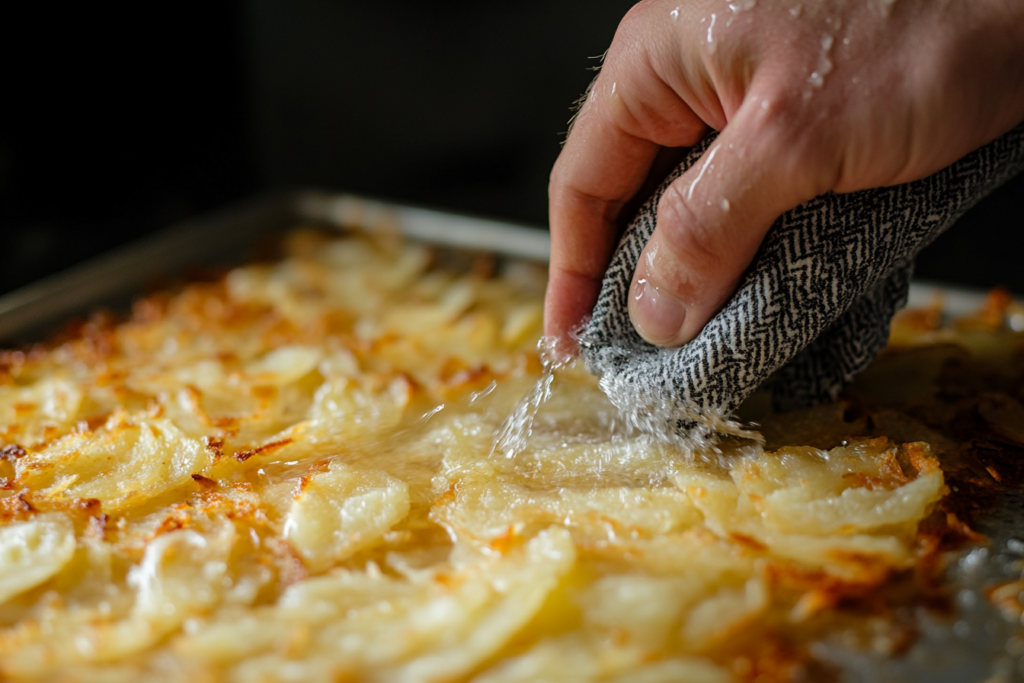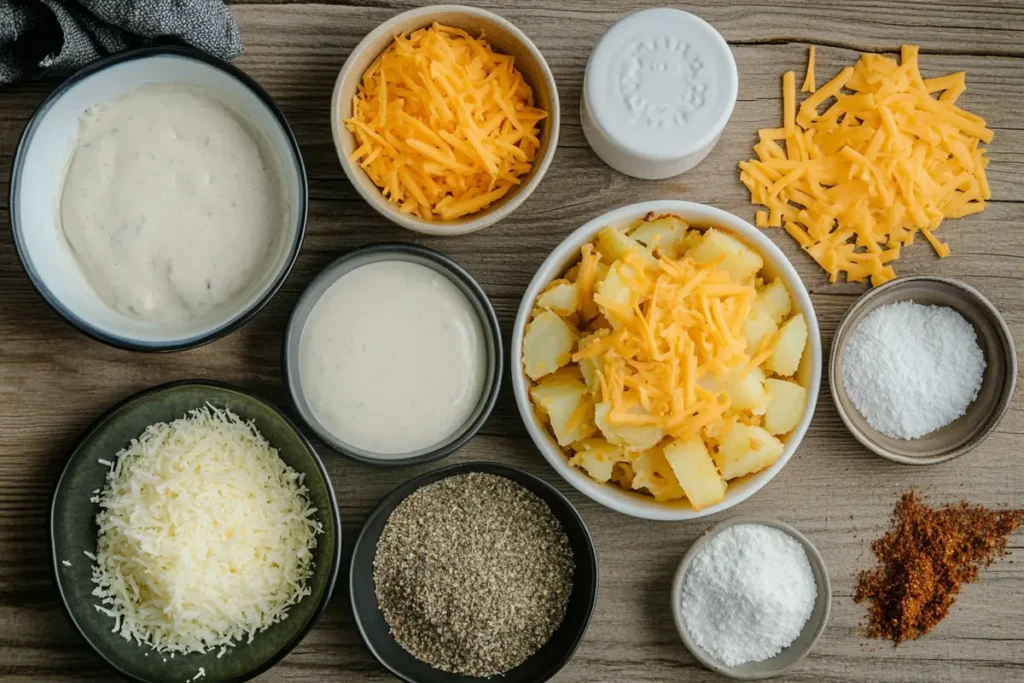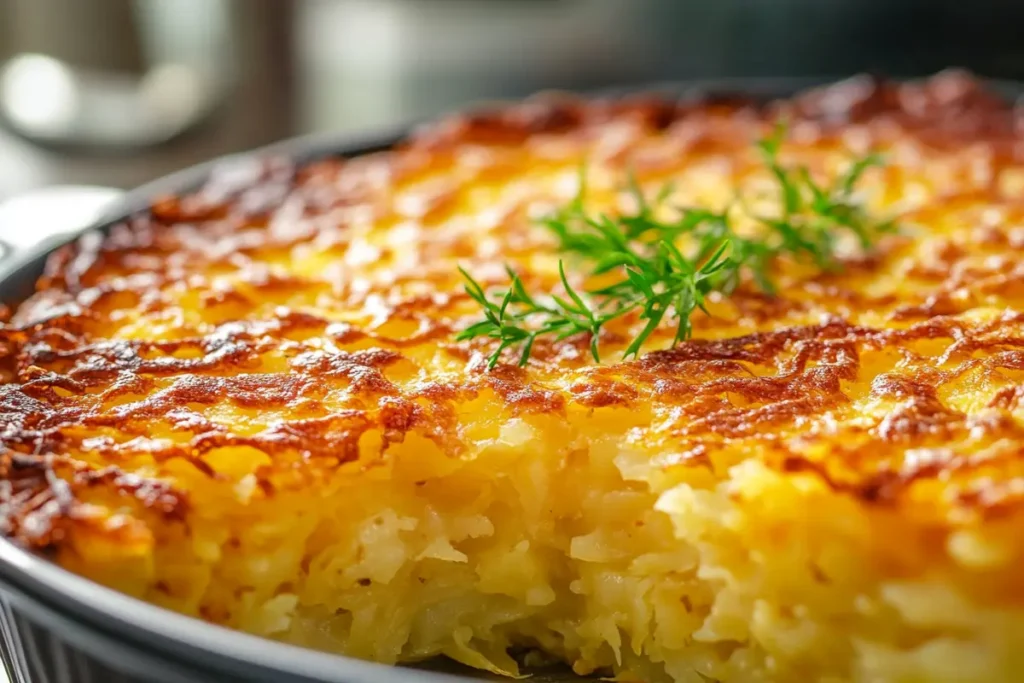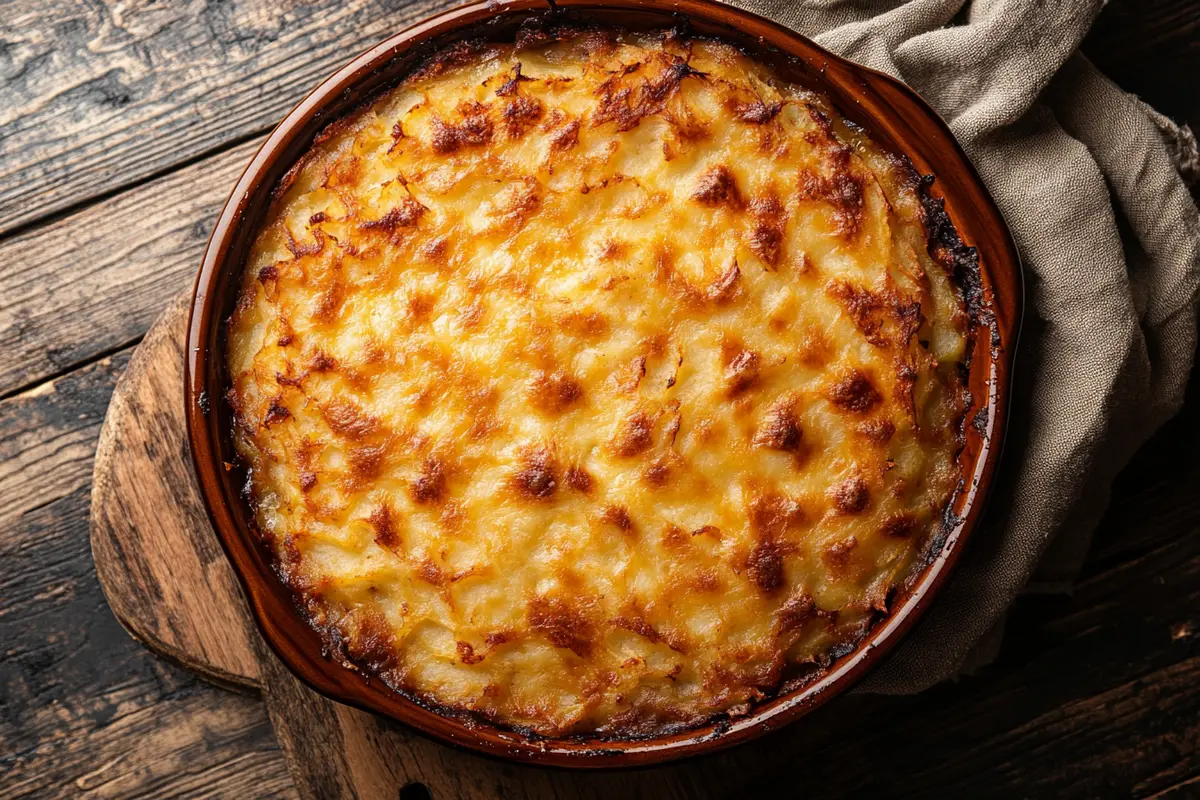Many home cooks have likely asked themselves, why is my hash brown casserole soggy? This dish should be crisp and golden, yet sometimes it turns out mushy or runny. Fortunately, understanding key reasons for soggy results can help you achieve a perfectly textured casserole every time.
In this comprehensive guide, we will discuss common mistakes, prevention methods, cooking techniques, and ingredient tips. We will also answer the most frequently asked questions about soggy casseroles. By the end, you’ll know exactly how to fix and avoid a watery casserole, allowing you to enjoy a rich, flavorful meal.
Common Reasons for Soggy Hash Brown Casserole
If you find yourself muttering, why is my hash brown casserole soggy? multiple factors could be at play. Let’s examine the most common culprits:
- Excess Moisture in the Potatoes
- Potatoes naturally contain water.
- If you don’t remove enough moisture, they can release liquid while baking.
- This excess liquid can make the entire casserole watery.
- Improper Thawing or Using Frozen Hash Browns
- Pre-packaged frozen hash browns often hold extra water.
- Thawing them incorrectly can lead to soggy outcomes.
- Proper thawing and draining is crucial.
- Too Much Dairy
- Milk, cream, or sour cream adds flavor.
- However, using too much can result in an overly wet casserole.
- Balancing liquids and solids is key.
- Not Baking at the Right Temperature
- If your oven is too cool, the casserole may not evaporate excess water.
- Inconsistent temperatures can leave some parts undercooked.
- Inadequate Cooking Time
- Rushing can cause the middle to remain undercooked.
- This often contributes to a soggy center.
- Covering the Dish During Baking
- A tightly covered casserole traps steam.
- As steam builds, condensation drips back, creating unwanted liquid.
Understanding these reasons can help you pinpoint issues. Next, we’ll delve into specific strategies to fix and prevent each one. That way, you can stop asking, why is my hash brown casserole soggy? and start enjoying a delectably crisp and creamy dish.
Managing Potato Moisture

Hash browns rely heavily on potatoes, which are high in water content. If this water remains in the shreds, it transforms your casserole into a soupier creation. Therefore, the first step to preventing sogginess is dealing with the potato liquid.
How to Reduce Moisture in Freshly Shredded Potatoes
- Dry Them Thoroughly: After shredding, place the potatoes in a colander and rinse to remove starch. Pat them dry with paper towels.
- Use a Salad Spinner: Surprisingly, a salad spinner can help remove excess water. Spin small batches until they feel mostly dry.
- Salt and Drain: Lightly salt the shredded potatoes and let them sit. This process draws out moisture. Then, squeeze them with a clean towel.
If You’re Using Frozen Hash Browns
- Proper Thawing: Thaw them in the refrigerator overnight. Quick-thawing on the countertop can lead to uneven results.
- Remove Excess Water: Place thawed hash browns on a dry towel. Press to remove any extra liquid.
- Avoid Overcooking: Once thawed, handle them gently. Overcooking or overhandling might break the strands.
Mastering these steps significantly lowers the chance of a watery casserole. After all, moisture is the usual answer to why is my hash brown casserole soggy?.
Balancing Dairy and Liquid Ingredients
A creamy hash brown casserole often contains milk, cream of mushroom soup, sour cream, or shredded cheese. These additions provide richness. However, using too much can introduce additional liquid.
Tips for a Balanced Creamy Layer
- Measure Accurately: Use measuring cups and spoons. Eyeballing can lead to accidental overuse of liquids.
- Choose Thicker Sauces: Thinner sauces or soups might increase water content. Opt for condensed soups if possible.
- Combine Ingredients Slowly: Stir dairy and potato mixtures gently to avoid breaking potatoes.
- Add Cheese Wisely: Cheese melts into a liquid-like consistency. Overloading cheese can tip the moisture balance.
Considering Low-Fat or Alternative Dairy
Using low-fat cheeses or dairy substitutes can sometimes produce more watery outcomes. Therefore, you may need extra binders like eggs or a spoonful of flour. Adjusting your ingredient ratio helps keep the casserole cohesive.
Importance of Proper Oven Temperature and Bake Time
An oven that’s too cool or too hot can wreak havoc on your casserole’s texture. Bake time also plays a huge role. If you remove your dish before it’s fully set, you’re likely to ask yourself, why is my hash brown casserole soggy?
- Preheat Your Oven
- Give your oven enough time to reach the set temperature.
- This step ensures the casserole starts cooking evenly.
- Check the Internal Temperature
- Insert a food thermometer in the center.
- Aim for at least 160°F (71°C), especially if raw eggs are involved.
- Use the Middle Rack
- Placing the dish too close to the top or bottom can create uneven heat distribution.
- The middle rack usually offers the most consistent results.
- Extend Cooking Time If Needed
- If the center remains wet, continue baking in 5 to 10-minute increments.
- Watch for a firm, golden crust.
- Uncover in the Final Stages
- If you must cover the dish initially, remove the lid or foil near the end.
- Let moisture evaporate to crisp the top.
Proper baking practices ensure your casserole sets well. This helps you avoid a gooey center and fosters that signature golden crust. Once you nail down these details, you’ll likely stop wondering, why is my hash brown casserole soggy?
The Role of Eggs and Other Binder
Some hash brown casserole recipes call for eggs or egg-based binders. Eggs help hold everything together, which can reduce sogginess. Yet, too many eggs could create a dense texture. Balancing these elements is key.
Using Eggs Effectively
- Whisk Thoroughly: Beat eggs until well-mixed before incorporating them.
- Spread Evenly: Pour the egg mixture evenly over the potatoes.
- Monitor Ratio: Use around one egg per cup to cup-and-a-half of potatoes or combined filler.
Other Potential Binders
- Flour: A small amount can absorb moisture.
- Cornstarch: Acts similarly but use it in moderation.
- Breadcrumbs: Offer structure and absorb leftover liquids.
Experiment with different binders if your casserole tends to be runny. Adjust small increments to find your sweet spot. That way, you’ll achieve a harmonious blend without dryness or goo.
Pre-Cooking Ingredients for Better Texture

Sometimes, why is my hash brown casserole soggy? stems from undercooked or watery add-ins. For example, onions and peppers release moisture as they cook. Meat, like sausage or bacon, can also hold fat or liquid that seeps out during baking.
How to Prevent Excess Liquid from Add-Ins:
- Sauté Vegetables: Cook onions, peppers, or mushrooms in a skillet. Drain any liquid before adding to the casserole.
- Brown Meats: Render fat from sausage or bacon. This step reduces greasy pockets.
- Drain Thoroughly: Pat cooked add-ins with paper towels to remove leftover oils or water.
This method ensures each component of your casserole contributes minimal unintentional liquid. It also helps concentrate flavors. Therefore, your final result tastes richer while maintaining a firmer bite.
Serving and Storage Considerations
Even after baking a perfect casserole, certain serving and storage practices might make it soggy. Cooling, reheating, and how you slice can all influence texture. Let’s explore:
- Let It Rest
- Allow your hash brown casserole to rest for 5–10 minutes after removing it from the oven.
- This resting time helps the structure set.
- Slice with Care
- Use a sharp knife or spatula.
- Cutting too aggressively might shred the layers and release trapped liquid.
- Reheating
- Warm leftover casserole in a low oven (around 300°F).
- This prevents rapid re-cooking that might create steam.
- Alternatively, cover loosely with foil to maintain some moisture.
- Proper Storage
- Transfer leftovers to airtight containers.
- Keep them in the refrigerator for up to 3–4 days.
- Excess air and moisture can degrade texture over time.
Monitoring how you serve and reheat ensures you enjoy the original consistency as much as possible. Taking these easy steps preserves the ideal moist-but-not-soggy texture.
Variations and Flavor Enhancements
Although the main question is why is my hash brown casserole soggy? you might also wonder how to elevate the dish. Once you master dryness control, you can explore creative twists.
Potential Add-Ins
- Vegetables: Bell peppers, broccoli florets, spinach, or tomatoes (seeds removed)
- Proteins: Cooked sausage, diced ham, shredded chicken, or bacon bits
- Cheese Blends: Cheddar, Monterey Jack, mozzarella, or pepper jack
Seasoning Ideas
- Herbs: Thyme, rosemary, or parsley can freshen flavors.
- Spices: Paprika, cayenne, or garlic powder add subtle heat.
- Toppings: Crushed cornflakes, panko breadcrumbs, or French-fried onions for crunch.
Be mindful that adding watery vegetables or extra cheese may reintroduce moisture issues. Always take steps to reduce or account for that extra liquid. This approach keeps your casserole from reverting to a soggy state.
The Importance of Quality Ingredients
Quality ingredients can drastically affect texture. For instance, cheap cheese might have extra fillers that release water during baking. Similarly, subpar frozen potatoes might contain more ice crystals.
- Choose Trusted Brands: Reputable dairy or potato brands often have consistent moisture levels.
- Opt for Fresh Over Processed: Whenever possible, shred your own cheese or grate your own potatoes.
- Inspect for Ice Crystals: If using frozen items, watch for excessive freezer burn, which translates to added moisture.
While it can be tempting to buy budget-friendly items, spending a bit more might pay off in better consistency and flavor. High-quality ingredients often create fewer problems when it comes to watery dishes.
Troubleshooting: Why Is My Hash Brown Casserole Soggy?

Let’s break down some quick solutions. If your casserole is already in the oven or just came out and looks soggy, try these rescue tactics:
- Remove Foil or Lid
- If covered, immediately uncover.
- Place the dish back in the oven to allow steam to escape.
- Increase Oven Temperature
- If it’s nearly done but still watery, bump the heat by 25°F.
- Bake a few more minutes, watching carefully to prevent burning.
- Drain Excess Liquid Mid-Bake
- If you see a pool of liquid on top, gently tilt the casserole to remove it.
- Then return it to the oven briefly.
- Add a Topping
- If watery pockets persist, sprinkle on a crunchy topping like breadcrumbs or crushed crackers.
- This topping absorbs some moisture.
- Recheck Internal Temperature
- Make sure you reach at least 160°F in the center.
- If it’s under, keep baking until fully set.
These tactics can save a casserole from complete ruin. However, prevention remains the ultimate goal. By incorporating earlier tips, you can skip emergency measures altogether.
Putting It All Together
To avoid ever asking again, why is my hash brown casserole soggy? follow these steps:
- Prepare Potatoes Correctly: Dry them thoroughly, especially if using frozen.
- Mind Liquid Ratios: Measure dairy ingredients accurately.
- Use Proper Binders: Eggs, flour, or cornstarch can help.
- Cook Add-Ins: Pre-sauté vegetables and brown meats.
- Monitor Bake Time and Temp: Ensure the center is cooked and the top golden.
- Uncover at the Right Time: Let steam escape to prevent watery outcomes.
By adhering to these guidelines, you’ll master the art of baking a crisp yet creamy hash brown casserole. Your family and friends will appreciate the effort, and you’ll save yourself the frustration of watery casseroles. No more sogginess!
Frequently Asked Questions
Below are some commonly asked questions related to soggy casserole and hash brown techniques. These FAQs provide further clarity on preventing and fixing watery issues.
1. How to make hash brown not soggy?
To make hash browns less soggy, remove as much moisture as possible. Pat the shredded potatoes dry with paper towels. If using frozen hash browns, thaw them thoroughly and press out excess water. Then, cook them at the correct temperature to allow steam to escape.
2. How do you fix a soggy casserole?
First, try uncovering it if it’s still in the oven. Increase the oven temperature slightly to help evaporate any liquid. You can also drain excess water by tilting the dish carefully. If the casserole is already out of the oven, reheat it in a skillet or place it back in the oven uncovered to dry it out.
3. Why is my breakfast casserole soggy?
A breakfast casserole can become soggy if you use too many liquid ingredients or if your add-ins contain extra moisture. For instance, raw vegetables can release water during baking. Also, undercooking the casserole or covering it for too long traps steam, which leads to sogginess.
4. How to make a casserole moist?
To keep a casserole moist without making it soggy, balance your liquids and solids. Include enough dairy or broth to infuse flavor but avoid oversaturating. Cover the casserole for part of the baking time, then remove the cover to let excess moisture escape. Proper cooking temperatures also help create a moist, not soggy, final product.

